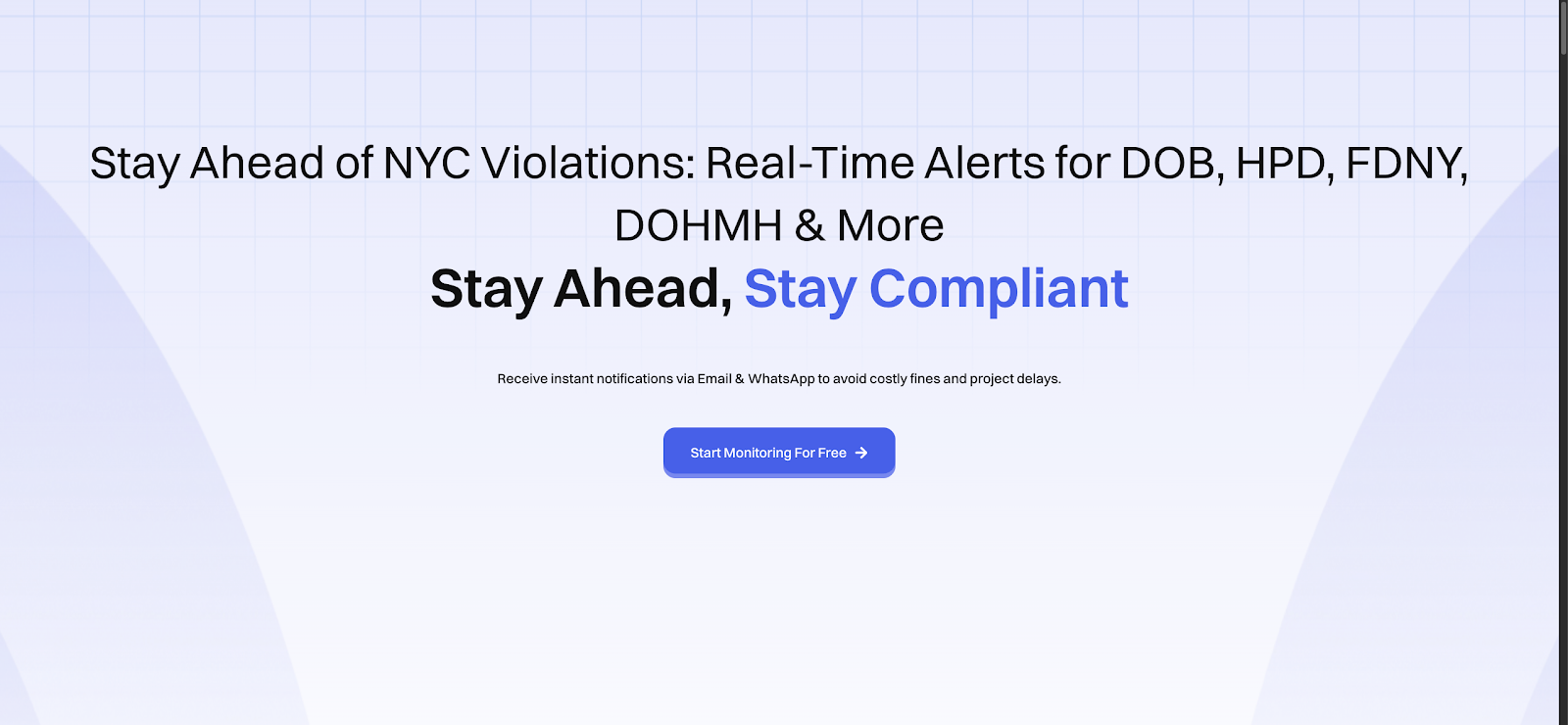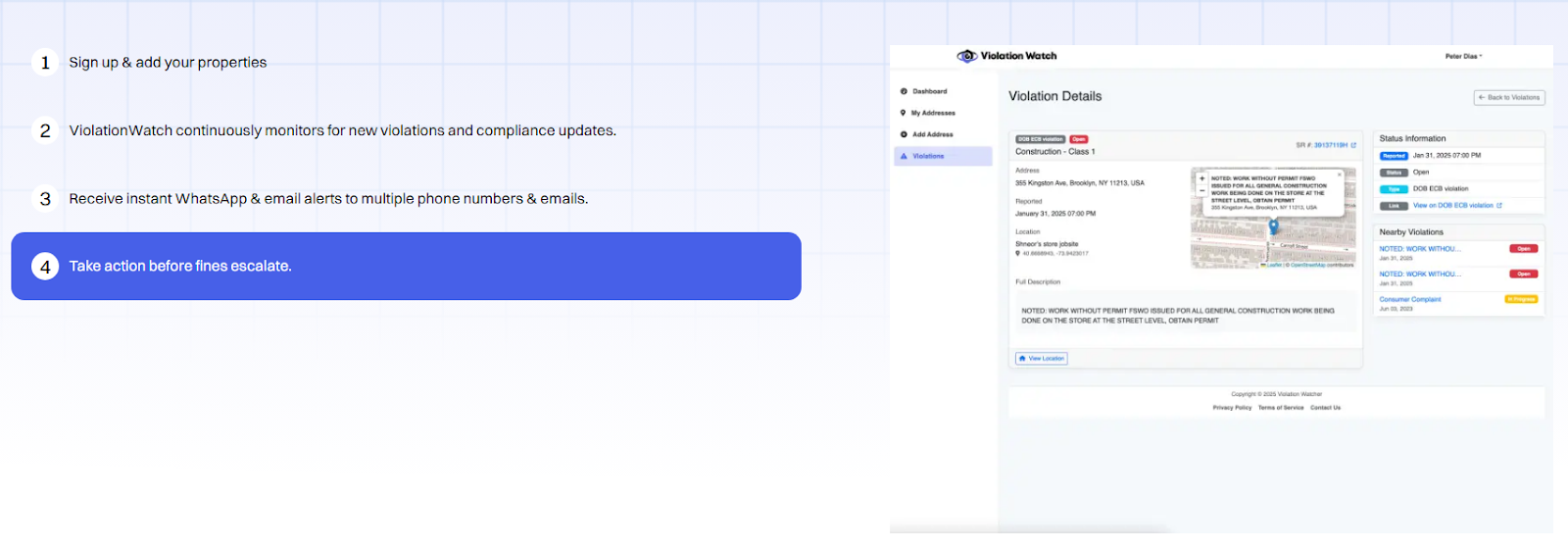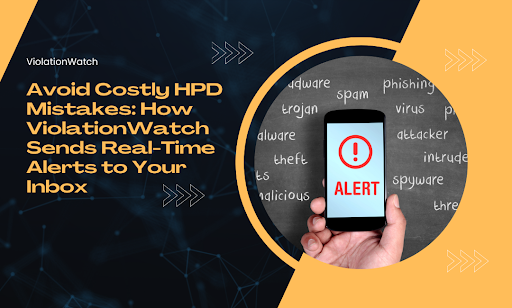That $25,000 HPD fine you just received? It started as a simple Class B violation three months ago. One missed deadline turned a minor repair into a financial nightmare that could’ve been avoided with a single email alert.
Every day, NYC property owners lose thousands to HPD violations—not because they refuse to fix problems, but because they never knew the violations existed. Or worse, they found out too late. HPD issues over 200,000 violations annually, and each one comes with strict deadlines that nobody reminds you about.
Here’s the reality: HPD doesn’t care if your mail got lost. They won’t forgive the fines because you were traveling. And they certainly won’t accept “I didn’t know” as an excuse when violations spiral into emergency repair orders and mounting costly penalties.
But what if every HPD violation triggered an instant notification to your inbox? What if you could track deadlines automatically and resolve issues before they multiply? That’s exactly what we’ll show you.
In this article, you’ll learn:
- What HPD violations really are and why property owners miss them (hint: it’s not carelessness)
- The true cost of HPD mistakes—from compounding fines to legal proceedings
- Why traditional tracking methods fail and leave you exposed to penalties
- How automated alerts prevent violations from becoming expensive disasters
- The exact system ViolationWatch uses to monitor and notify tenants and property owners of HPD issues instantly
No theory. Just practical strategies to protect your properties and your wallet from HPD’s strict enforcement system.
What HPD Violations Actually Are—And Why They Slip Through the Cracks
HPD violations aren’t just paperwork. They’re legally binding orders that demand specific actions within strict timeframes. When the NYC Department of Housing Preservation and Development inspects your building, they’re checking everything from lead hazards to heating systems, window guards to carbon monoxide detectors in residential buildings.
Three violation classes determine your urgency level:
- Class A (Non-hazardous): Minor issues like peeling paint in common areas—24 hours to 90 days to fix
- Class B (Hazardous): Problems affecting tenant safety, like broken locks or defective plumbing—30 days maximum
- Class C (Immediately life threatening): Severe dangers like lead-based paint in apartments with children under 6—must fix within 24 hours
The numbers tell a sobering story. HPD issued 567,825 violations in 2023 alone, according to the NYC Open Data portal. That’s over 1,500 violations every single day across the five boroughs of New York City.
The Perfect Storm of Missed Violations
Property owners miss HPD violations for surprisingly simple reasons. First, the notification system relies on physical mail sent to your registered address. Changed management companies recently? Moved offices? That violation notice is sitting in limbo while penalties accumulate daily.
Second, HPD inspectors can issue violations without anyone being present. They’ll post a notice on the building, but if you don’t visit daily, you’ll miss it. By the time you discover that Class C violation, you’re already facing fines and potential emergency repair orders.
Third, the sheer volume creates chaos. Managing multiple properties means tracking dozens of potential violations across different buildings, residential units, and deadlines. One overlooked notice among the pile of daily mail becomes an expensive oversight.
Why Traditional Tracking Falls Apart: What Local Law Requires
Spreadsheets work until they don’t. Most property owners start with good intentions—logging violations, setting calendar reminders, and assigning repairs. But HPD’s system operates on its own timeline, and manual tracking can’t keep pace.
HPD updates violation statuses online, but checking each property manually every day isn’t realistic. Meanwhile, violations can escalate without warning. That Class B violation you thought you had 30 days to fix? HPD can upgrade it to Class C if conditions worsen, shrinking your timeline to 24 hours.
The certification requirements add another layer. You must certify corrections through HPD’s online portal with specific documentation. Miss the certification deadline—even if you completed repairs—and you face additional fines plus the original penalties. Failure to submit the proper correction form on time guarantees extra charges.
When HPD Violations Turn Into Financial Disasters

HPD violations start small but multiply fast. What begins as a $250 fine for a Class B violation can snowball into tens of thousands in penalties, legal fees, and emergency repairs. The math gets ugly quickly.
Here’s how costs compound:
- Initial violation fine ($250-$1,500 depending on class)
- Daily penalties for non-compliance ($250-$1,000 per day)
- Reinspection fees ($200 per visit)
- Emergency repair costs if HPD intervenes (typically 20-40% above market rates)
- Administrative fees and interest on unpaid fines
- Legal representation when violations escalate to housing court
The Hidden Expenses Nobody Talks About
Beyond fines, HPD violations trigger expensive chain reactions. Your property insurance premiums spike after multiple violations appear on record. Banks scrutinize HPD violation histories during refinancing, potentially blocking access to better rates or requiring immediate resolution before approval.
Tenant lawsuits become more likely—and more expensive—when HPD violations exist. Lawyers use violation records as evidence of negligence, strengthening tenant complaints for rent abatements, damages, or lease terminations. One unresolved violation can cost you months of rental income plus legal defense fees.
When Violations Become Criminal
HPD violations can escalate beyond civil penalties. Ignore Class C violations involving lead paint, illegal conversions, or life-threatening conditions, and you face criminal prosecution. The city doesn’t hesitate to file charges against property owners who repeatedly fail to address immediately hazardous conditions.
Criminal convictions mean more than fines. You’re looking at potential jail time, permanent criminal records, and loss of professional licenses. The city can also place liens on your property, forcing a sale to recover costs if violations and penalties remain unpaid. HPD regulations carry serious weight, and legal action follows swiftly for those who ignore them.
Emergency Repair Orders—The Worst-Case Scenario
When HPD loses patience, they issue Emergency Repair Orders (ERO). The city hires contractors to complete repairs immediately, then bills you at premium rates. You lose control over contractor selection, work quality, and costs.
ERO charges regularly exceed standard repair costs by 30-50%. A $5,000 boiler repair becomes a $7,500 city-managed project. Plus, you still pay all accumulated fines and penalties on top of inflated repair bills.
The financial impact extends beyond immediate costs. Multiple violations create a public record that follows your property, affecting resale value and deterring quality tenants who research building histories before signing leases.
How Automated Alerts Stop Small Problems From Becoming Big Penalties
Real-time violation alerts change everything. Instead of discovering violations weeks later through physical mail, you get instant notifications the moment HPD posts them online. That 24-hour Class C deadline? You know about it within minutes, not days.
Automated systems transform violation management by:
- Scanning HPD databases continuously for new violations
- Sending immediate email or text alerts when violations appear
- Tracking deadline countdowns for each violation class
- Monitoring status changes and escalations in real-time
- Alerting you before certification deadlines expire
The Power of Instant Knowledge
Speed matters with HPD violations. Getting notified immediately means you can dispatch repair crews while materials are available and contractors aren’t booked solid. You avoid the panic of last-minute fixes that cost double on an emergency notice.
Automated alerts also catch the violations you’d never see otherwise. Those issued during inspections when nobody’s present. The ones posted to alternate addresses. The escalations that happen silently in HPD’s system. Every violation gets flagged and delivered straight to your inbox, eliminating dangerous blind spots that lead to compounding fines.
The ViolationWatch System That Catches Every HPD Issue Before It Costs You

Traditional violation tracking fails because it relies on human vigilance. You check HPD’s website when you remember. You hope mail arrives on time. You trust that nothing slips through while you’re managing daily operations. But HPD violations don’t wait for convenient timing.
ViolationWatch eliminates these dangerous gaps with automated monitoring that never sleeps. The system continuously scans HPD databases for new violations across your entire portfolio, catching issues the moment they appear online, often before physical notices even get mailed.
Why Real-Time Alerts Beat Every Other Method
Manual checking can’t compete with automated surveillance. While you’re dealing with tenants, contractors, and daily emergencies, ViolationWatch monitors HPD’s systems 24/7. No forgotten checks. No missed updates. No surprises when you finally log into HPD’s portal weeks later.
The difference shows in the results. Property managers using automated alerts resolve violations 73% faster than those relying on manual tracking. They avoid late fees, prevent escalations, and maintain better tenant relationships by addressing issues promptly. Following proper tenant communications protocols becomes easier when you know about violations immediately.
How the Monitoring Process Works
ViolationWatch’s system operates through a straightforward yet powerful process:
Step 1: Simple Property Setup

You add your properties once using just the address or block and lot numbers. The system immediately begins monitoring all associated violations—past, present, and future. Whether you manage three or more units or an entire portfolio, setup takes minutes.
Step 2: Continuous Database Monitoring

ViolationWatch’s technology checks HPD databases multiple times daily for changes. New violations, status updates, deadline modifications, and certification requirements all trigger the notification system. This includes monitoring for fire safety violations, annual inspection requirements, and other critical compliance issues.
Step 3: Instant Multi-Channel Alerts

The moment a violation appears, ViolationWatch sends immediate notifications through WhatsApp and email to multiple team members. Everyone who needs to know gets alerted simultaneously—no delays, no missed messages.
Step 4: Strategic Action Before Escalation

With instant knowledge comes immediate action. You dispatch repairs, gather documentation, and meet deadlines with time to spare instead of racing against HPD’s clock. This proactive approach helps you stay ahead of violations and avoid emergency situations.
The Game-Changing Multi-Channel Alert System
Here’s where ViolationWatch transforms violation management completely. Instead of relying on single-point notifications that you might miss, the system delivers alerts through multiple channels to multiple team members simultaneously.
You can configure alerts to reach:
- Property managers via email
- Maintenance supervisors through WhatsApp
- Building superintendents on their phones
- Ownership groups at their preferred contacts
- Legal teams, when Class C violations appear
This multi-channel approach means violations never hide in a single person’s inbox. When HPD issues a Class C violation at 4 PM on Friday, your entire team knows instantly, not Monday morning when someone checks email.
WhatsApp Integration That Actually Works
Email alerts work until they don’t. They get buried in crowded inboxes, caught in spam filters, or ignored during busy periods. WhatsApp notifications cut through the noise with immediate, unmistakable alerts on the devices your team checks constantly.
The WhatsApp integration sends:
- Violation type and severity level
- Exact property address affected
- Specific deadline for compliance
- Direct link to full violation details
- Current status updates as they change
Your superintendent gets the same alert as your property manager. Your maintenance team knows what needs fixing before you even call. This synchronized communication prevents the costly delays that turn minor violations into major expenses.
Customizable Alert Rules That Match Your Workflow
Not every violation needs to wake up the CEO. ViolationWatch lets you create intelligent alert rules based on violation severity, property location, or team responsibilities.
Class C violations might alert everyone immediately. Class A violations could go only to the maintenance staff during business hours. Properties under renovation might be routed to construction managers instead of regular teams. You control who gets notified about what, and when. The system helps you document all violations properly and verify that the right team members are responsible for each issue.
Beyond Basic Notifications
ViolationWatch doesn’t just tell you about violations. The platform provides complete context for informed decision-making:
- Historical violation patterns for each property
- Compliance deadlines with countdown timers
- Required documentation for proper certification
- Direct access to HPD’s official violation details
- Tracking tools for repair progress and costs
This comprehensive approach turns reactive scrambling into proactive management. You see patterns, anticipate seasonal violations, and address systemic issues before they generate multiple citations. When remediation is required, you’ll know exactly what needs to be done and when.
The unified dashboard (learn more about why this matters) brings every violation across your portfolio into one view. No more logging into multiple systems or maintaining separate spreadsheets for different properties. Everything lives in one place, accessible from any device.
For property managers juggling multiple buildings, this centralized approach saves hours weekly. Instead of checking each property individually on HPD’s website, you see all violations, deadlines, and statuses at a glance. Filter by urgency, property, or violation type to focus on what needs immediate attention. The system tracks all required permits and follows best practices to ensure full compliance with NYC law.
Understanding common mistakes other property owners make helps you avoid similar pitfalls. With ViolationWatch monitoring your properties, you’ll never miss critical updates or deadlines again. The local law requires prompt attention to violations, and this system ensures you meet every requirement. The risk of missing violations disappears when technology handles the monitoring for you.
Stop Playing HPD Roulette—Start Using ViolationWatch
You’ve seen how automated alerts transform violation management from reactive chaos to proactive control. The difference between success and expensive disasters comes down to one thing—knowing immediately.
Key takeaways that save you money:
- HPD violations multiply fast when you rely on physical mail that arrives days or weeks late
- Real-time alerts give you the 24-hour head start needed for Class C violations
- Multi-channel notifications ensure your entire team knows instantly, not just one person
- Automated monitoring catches status changes and escalations before fines compound
Manual tracking leaves you exposed to HPD’s strict deadlines and mounting penalties. ViolationWatch monitors every violation across your portfolio 24/7, sending instant alerts that keep you ahead of costly mistakes. Start protecting your properties today.

